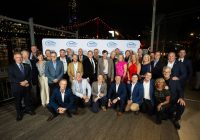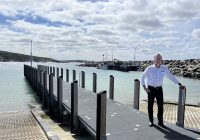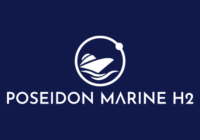The annual Interferry Conference was held in Seattle in early October and continued to deliver on its primary goal of facilitating positive networking opportunities and cooperation within the global ferry industry. With annual ferry passenger numbers each year similar to that of airline passengers, the importance of this industry within the maritime sector cannot be understated.
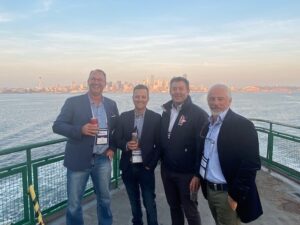
Some of the representatives of the Australian delegation enjoying Puget Sound during Interferry 46 in Seattle.
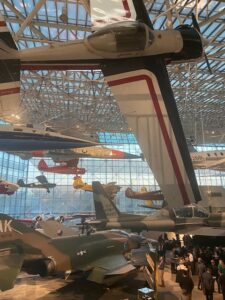
Interferry 46 was a packed five-day program hosted by Washington State Ferries and FRS Clipper servicing Vancouver Island, Canada. This year conference delegates visited local Puget Sound companies and destinations including the ‘Museum of Flight’ with all activities providing many opportunities for networking between attending delegates from the ferry industry.
Australian ferry industry-based organisations were well represented at the conference and included AusShips, Austal, AMSA, Ayres Composites, Beurteaux, Incat, Incat Crowther (AUS, UK, USA) , IMS, Liferaft Systems Australia, NRMA, One2Three Naval Architects, Penske Australia, Riverside Marine, Sealink Australia, Spear Green Design, TT-Line (Spirit of Tasmania), UES Marine and the Australian International Marine Export Group.
The range of discussion topics were as varied as they were detailed. The ‘Keynote Address’ delivered by Tremain Holloway, Highline Maritime High School, Washington, USA opened the conference focusing on a common global challenge of how to engage young people in a maritime career. Further session ‘blocks’ covered other common challenges facing the industry including ‘Making Onshore Power Supply a Reality’ and ‘Bridging the Gap through Automation’.
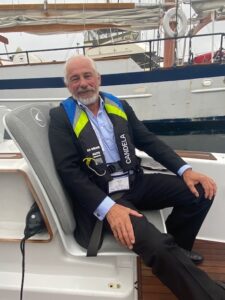
Jeremy Spear, Director, Spear Green Design on the Technical Tour, Interferry 46

Robert Clifford, Chair & Founder, Incat about to address the audience at Interferry 46
Heavy on the agenda were subjects including Electrification, Fast Foiling Ferries, Environmental Sustainability and Environmental Excellence, Power – Supply, Transition, Automation, Fuels – from Hydrogen to Biofuels and much more, Zero Emission Propulsion / Destination Zero, Energy Storage, Efficiencies and Green Initiatives, New Engines, Vessels and Vessel Types and much more.
The ‘Vessel Project Features’ presented detailed information for delegates with sessions included on ‘Unlocking Potential of Urban Water Transport – Long-range, Fast Electric Ships’ presented by Erik Eklund from Candela, Sweden and ‘Construction and Certification of the First Hydrogen Fuel Cell Powered Passenger Vessel’ presented by Tony Thomas, Cummins, USA and Terry Federer, All American Marine, USA.
Eklund spoke on their commercial vessels being ‘super-efficient’ across the board. Building lighter weight vessels translates through to easier docking facilities whereby smaller vessels such as water taxis can easily dock on simple floating pontoons. For larger passenger ferries, with hydrofoils and little to no wake, it translates into vessels travelling at faster speeds in local waterways delivering passengers to their destinations in record time and with a faster turnaround for disembarking and picking up at stops.
A ‘Flash Presentation’ from Austal Australia promoted their VOLTA range via a short video clip presenting their newest member – the Austal VOLTA Auto Express Catamaran – a large electric passenger and vehicle carrier with optimised weight and efficiency for operators on the pathway to achieve net zero emissions.
The stand-out conference sessions were the two ‘Ferry Leaders Panel’ sessions of ‘Power & People’ on Day 1 followed by ‘Innovators and Disruptors’ session at the close of Day 2 prior to the closing ceremony.
The ‘Power & People’ speakers introduced their sustainability journeys and the challenges of effective affordable decarbonisation strategies and solutions. They also strongly acknowledged how their people and teams throughout their organisations were integral to achieving this success.
The Day 2 session ‘Innovators and Disruptors’ panel of expert industry speakers provided candid updates on their company’s developments as they target zero emissions and develop further weight reducing solutions for foiling vessels.
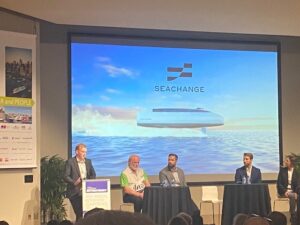
Max Olsen, Seachange presenting ‘Innovators & Disruptors’ session as part of the “Ferry Leaders Panel 2’
Although foiling passenger ferries have been in the marketplace for many years, the passenger ferry industry across the globe continues to strive for further gains in efficiencies as they look to redefine waterborne transportation. This includes targeting zero emissions; greater electrification with shorter battery recharge times; increased automation to reduce labour costs; reduction in service and maintenance time; and lastly – make the move to the use of lighter hull materials to reduce friction to the point where hydrofoils can lift out of the water completely.
Robert Clifford, Chair & Founder, Incat made a short introduction and was straight to the point regarding the challenge of reducing overall vessel weight for efficiency gains by posing the question to the audience on why are ship builders still building passenger ferry hulls in steel ?
Relative newcomer to Interferry Max Olsen, CEO, Seachange from New Zealand spoke of some of the Seachange team being involved with the high-performance design teams for an America’s Cup syndicate. Armed with this background and experience and with a strong emphasis on sustainability, Seachange will be offering a standard hydro foiling design model that can be modified for tourism, recreation or transportation purposes. They are starting with a smaller range of boats with water taxis at the 8m up to 18m carrying 100 passengers with a low capex per seat.
Billy Thalheimer, REGENT USA provided an update on their SeaGliders – hydrofoil sea planes – that are now a reality. REGENT has succeeded in taking off on hydrofoils and transferring to a wing in one move – a first – using a small hydrofoil vessel with a 5.5 metre wingspan. Ever forward-thinking, FRS stole the show as a disruptor by revealing plans for an electrified Ekranoplan / WIG vessel, with the “just above sea level flight” concept launched bearing FRS’s striking red and white livery.
Australia is a leading player in the global passenger ferry industry with on-shore experts available in naval architecture, shipbuilding, marine interior design and fit-out plus world-class service and maintenance facilities. Currently Australia has designed and built fully customised passenger ferries in service in over 70 countries. Over 4.27 billion passengers and 373 million vehicles were transported in 2019 across 15,400 vessels and these numbers will have likely increased since then with Covid restrictions lifted in most countries.
Interferry 2023 will be held in Hobart, Tasmania from November 4 –8 hosted locally by the Spirit of Tasmania (TT-Line Pty Ltd). It presents a huge opportunity for Australian based commercial marine businesses to attend and connect with some of the world’s largest global players in the international ferry industry.
For more information on Interferry 2023 click here.









